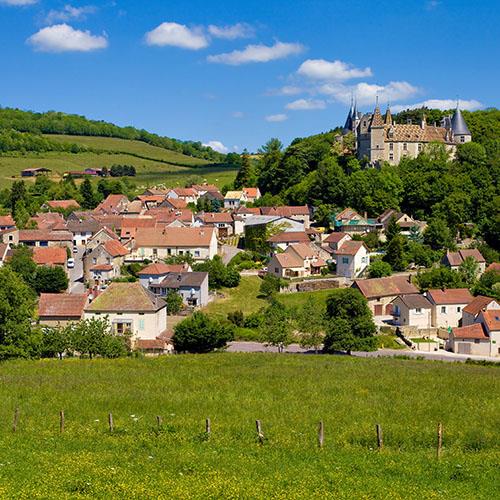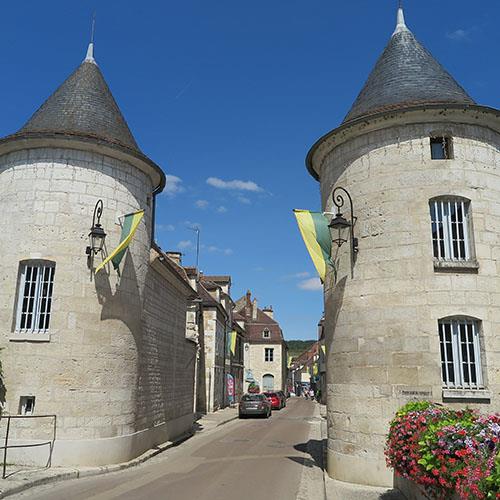EXPERIENCE COTE-D'OR

Overview
The Côte d'Or département, situated in the Northeast section of Burgundy, is the most popular and historically wealthy regions of Burgundy. The area stretches from Dijon, filled with cultural riches, south to the wine town of Beaune and beyond. Highlights of Côte d'Or include famous vineyards, the walled, hilltop town of Semur-en-Auxois, the idyllic Cistercian monastic site Abbaye de Fontenay, and the historic Alésia battlefield where Julius Caesar finally vanquished the Gauls in 52 BC. Wine enthusiasts will love exploring the vineyards along the Route des Grands Crus that passes through the Cote d’Or department from Santenay to Dijon, with numerous opportunities to sample the wines en route and enjoy the picturesque countryside where the grapes are grown.



Things to See and Do
The Unesco World Heritage site, Abbaye de Fontenay was founded in 1118. Exploring the Abbey offers a captivating look of the serene surroundings where the Cistercian monks lived lives of contemplation and strenuous manual labor. Sitting beside a tranquil stream, this monastic architecture is not to be missed with an unadorned Romanesque church, a barrel-vaulted monk’s dormitory, and Europe’s earliest metallurgical forge.
Château de la Rochepot rises above the ancient village of La Rochepot, just 11 miles southwest of Beaune. With its Conical towers and multicolored tile roofs, this fabulous medieval fortress offers amazing views of the surrounding countryside. Explore the interiors where you’ll find a combination of weapons and the fine paintings. The chateau makes a perfect excursion and can be combined with a visit to some area vineyards.
While in Dijon, be sure to visit the fabulous 19th-century covered market, Les Halles, even if only to take in the sights and aromas. Designated as a national monument in 1975 (when it narrowly escaped demolition), its numerous stalls buzz with activity four mornings a week, with Saturdays drawing the biggest crowds. It's the perfect place to mingle with Dijonnais locals while stocking up for a picnic of fresh produce, cheeses and charcuterie. The area outside the Halles building and the surrounding streets are also packed full of vendors selling produce, clothing, souvenirs, and much more.
Église Notre Dame, located in Dijon, was built in the 13th century in a gothic design and features gargoyles and unusually thin columns. Atop the church, the 14th-century Horloge à Jacquemart, transported from Flanders in 1383 by Philip the Bold who claimed it as a trophy of war, chimes every quarter-hour.



Museums
Musée des Beaux-Arts, located in Dijon, is housed in the fabulous Palais des Ducs de Bourgogne and is one of the oldest museums in France. The museum underwent extensive renovations, reopening in 2013 with modern technology, interpretation, and information systems to complement the wonderful collections. The beginning part of your visit focuses on Burgundy and the history of the Duchy of Burgundy. Highlights include the ornate tombs of Philip the Bold (Duke from 1363-1404) and his son John the Fearless (Duke from 1404-1419) and his wife Margaret of Bavaria. Other sections highlight Egyptian art, the Middle Ages in burgundy and Europe, and six centuries of European paintings.
Musée du Pays Châtillonnais Trésor de Vix houses the Vix Treasure, a collection of Celtic, Etruscan and Greek objects from the 6th century BC. The treasure was discovered in 1953 in the tomb of the Dame de Vix, a Centic princess who controlled the trade in Cornish tin in the 6th century. Mined in Cornwall, the tim was brought by boat up the Sine as far as Vix and then carried overland to the Saône and the Rhône, where river vessels brought it south to Marseille and to the greeks. The amazing collection includes a breathtaking massive Greek krater, the largest known bronze vessel from the ancient world.
The Château du Clos de Vougeot is a beautiful estate that provides a fabulous introduction to Burgundy’s wine-producing techniques. The chateau was originally the Abbaye de Citeaux, the 16th-century country castle served as a gateway for the abbots. A tour of the estate displays enormous ancient wine presses and casks.
The Gothic Hôtel-Dieu des Hospices de Beaune, built in 1443, served as a hospital until 1971 and is one of France’s most prestigious historic monuments. Its polychrome roofs and a renowned vineyard make this museum one of Burgundy’s finests. A highlight here is the 148 acre wine estate that produces esteemed wines, sold at auction on the third Sunday in November.




Cities, Towns, and Villages
Chatillon-sur-Seine, located in the heart of the Chatillonais region of the Cote d’Or, is a beautiful riverside village known for its ancient ‘treasure of Vix’ found nearby and now on display in the museum in town. You’ll also discover a charming 10th century Church of Saint-Vorles in the village.
Close to Fontenay Abbey, the town of Montbard is a three star 'ville fleurie' (town in bloom) that passes over by the Burgundy canal. The town is beautiful to stroll with an impressive Parc Buffon, named after a famous 18th century French naturalist.
Just to the south of Montbard, check out the picturesque town of Semur-en-Auxois, with an extensive historic center, it’s definitely one of the most beautiful towns in the Cote d'Or department.
To the east of Semur, Flavigny is a charming village with fortified walls and a unique selection of religious buildings to admire. You will also see aniseed being made by the local monks. This village was made famous when it became the setting of the popular film, ‘Chocolate.’
To the south-west of the department the town of Saulieu is best known for its 12th century romanesque style basilica. Saulieu sits in the rolling woodland countryside of the Morvan Regional Parc, an extensive natural region very popular with hikers and cyclists.
Dijon, located in the south east area of Cote d’Or, is the capital city of the department, this is a great starting point for exploring the area. The city honors the French gastronomic tradition with its mustard, its blackcurrant cream, and its gingerbread. Its medieval core with many old streets and buildings have been restored bearing many monuments of interest and is one of the favorite towns in France.
To the north-east of Dijon you can visit the small village at Beze, then to the south-west of the town check out the pretty hilltop village at Chateauneuf-en-Auxois.
Towards the southern border of the department be sure to see Beaune, a beautiful town with the medieval Hotel-Dieu (medieval hospital). Of course, Beaune also gives its name to one of the most prestigious wine regions in France.
The interesting town of Auxonne on the Saone River also has several historical buildings including a cathedral, castle, and a charming center to explore.